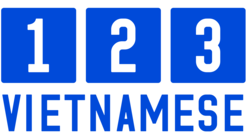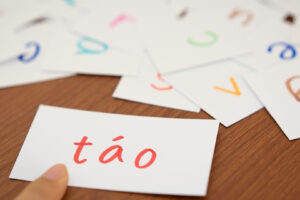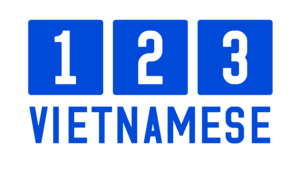Hội thoại #8: Đi mua sắm
Bản dịch:
– My name’s Cathy, from https://123vietnamese.com.
– Welcome to lesson 8: Go shopping
– Hi Tony, what do you want to do today?
– Ah, do you want to go shopping?
– I need a new suit for work.
– Of course, I’d love to go shopping.
– I know a big market with large clothes shops.
– Ok, let’s go – Xin chào – Bạn muốn gì? – Để tôi xem đã. – Vâng
– Let’s look around the shop , Tony.
– When the shop assistant asked you,
– what do you want?,
– you said “để tôi xem đã “. What does that mean?
– Để tôi xem đã it means “to have a look”.
– Xem means “to look”
– That’s interesting.
– So by saying “để tôi xem đã”
– you told to the assistant you want to look around.
– Yes. Here are the shop sections.
– Is there anything you like?
– Cái này rất tốt.
– Yes, that’s a nice shirt.
– The new word here is “shirt”.
– Shirt in Vietnamese is “áo sơ mi”. “Áo sơ mi”.
– Áo sơ mi. I’ll try it on but I think it is ok.
– How would I ask “Can I try it on”?
– Tôi có thể thử không it means “can I try it on?”
– Có thể is a verb
– and it means “may” or “can”
– It is using when you want to ask for permission. “Thử” means “to try”
– Ok, I’ll keep it in my mind.
– So “tôi có thể thử không” means “I can try?”
– or “can I try it on?”. You can go to the assistant and
– ask: “Xin lỗi, tôi có thể thử không?”.
– Xin lỗi means “excuse me”.
– You can use these words when you need someone attention. “Xin lỗi”
– Xin lỗi – Vâng?
– Tôi có thể thử không?
– Vâng
– This is a bit small.
– Medium size usually fits me perfectly
– but this one is too small for me.
– That’s because the Vietnamese size
– is a bit smaller than USA and European size.
– You might try a larger one. Xin lỗi, Cái này quá bé.
– Cái này to.
– Cảm ơn.
– Here Tony, try this size.
– Ok, what did you say there?
– I say that this one is too small.
– Quá means “too/very”
– Bé is word for “small”.
– quá bé it means “too small”
– and I say “Xin lỗi, cái này quá bé”. “Xin lỗi” – “excuse me”.
– Cái này – “this one”, “quá bé”- “too small”.
– So “Xin lỗi, cái này quá bé”
– means “excuse me, this one is too small”.
– And she said “cái này to”
– I know “cái này” is for “this one”, what does “to” mean?
– To means “big”. “To”
– so she said “cái này to” means “this one is big”
– Ok, what do you think?
– This size fits perfectly now.
– Yes, that shirt looks good.
– Bạn muốn áo sơ mi này không?
– Muốn
– Xin lỗi, cái này bao nhiêu tiền?
– Ba trăm nghìn. – Đắt quá
– Hai trăm nghìn.
– Tốt. Ok, Tony. Do you want to buy it?
– That’s a very good price.
– Cảm ơn
– Cảm ơn. That’s a good.
– Do you want to teach me what you said?
– Bao nhiêu tiền that are “how much?
– Bao nhiêu is how many”, “tiền” is “money”. So “bao nhiêu tiền?” is “how many money?”.
– This is how to ask how much something cost?
– Ok, then she answer “Ba trăm nghìn”.
– I know “ba” is “three”. What does “trăm nghìn” mean?
– Trăm means “hundred”. “Trăm”.
– Nghìn means “thousand”. So “ba trăm nghìn” means “three hundred thousand”
– Ok.
– Then I said “Đắt quá”.
– Đắt is “expensive”.
– Đắt and you already know “quá” is “too/very”.
– Ah, I already know “quá” is “too/very”.
– So “Đắt quá” is “too expensive”.
– So then she said “hai trăm nghìn”
– which means “two hundred thousand”
– Ok I know.
– That’s a good price.
– So I said “tốt” which means “good”.
– In this case that means I agree with that price.
– Ok. Can we bargain with everything in Vietnam?
– Yes, in most places we should never accept the first price.
– Bargaining is possible in almost market and store.
– However, big shopping centers and department stores have a
– fixed price and bargaining is not necessary in those places.
– I’ll have to study more Vietnamese number
– if I want to improve my bargaining skill.
– Yes, I will teach you those soon.






